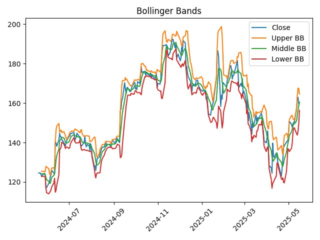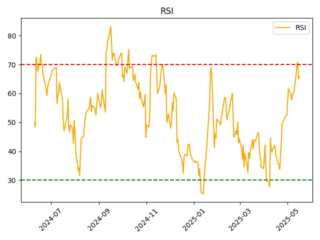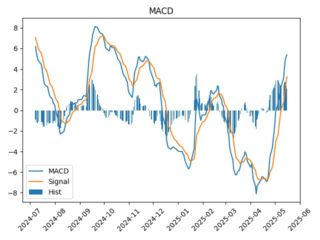Oracle (ORCL) Stock Forecast – Predictions & Technical Analysis 21.10.2025
Oracle stock forecast for October 2025
Current Market Position of Oracle Stock
Oracle shares are currently trading at $1.75, showing moderately positive momentum that surpasses key support levels. This positioning suggests a resilient performance amid broader market fluctuations, potentially offering both stability and growth opportunities for investors seeking technology exposure.
The current trading session began at $1.74, reaching a high of $1.75 and a low of $1.73. This relatively tight trading range indicates investor confidence while demonstrating sufficient liquidity and market interest in the stock.
Market Capitalization and Trading Range
With a market capitalization of approximately $4.90 billion, Oracle maintains its position as a significant player in the enterprise software landscape. The company's 52-week trading range spans from $1.25 to $2.16, highlighting considerable price movement over the past year and offering strategic entry points for varying investment approaches.
Dividend Performance
Oracle currently offers:
Dividend per share: $0.0054
Dividend yield: 0.36%
Ex-dividend date: April 9, 2025
Payment date: April 23, 2025
While the dividend yield remains modest compared to traditional dividend stocks, Oracle's consistent payment schedule provides a supplementary income stream alongside potential capital appreciation.
Technical Analysis Deep Dive

Technical indicators offer valuable insights into Oracle's price momentum and potential future movements. A comprehensive examination reveals several noteworthy patterns and signals worth monitoring.
Moving Averages Assessment
Moving averages serve as critical reference points for understanding Oracle's price trends:
Simple Moving Average (SMA) 50: $1.57
Simple Moving Average (SMA) 200: $1.75
Exponential Moving Average (EMA) 20: $1.63
Exponential Moving Average (EMA) 50: $1.62
The current price positioning above both the 50-day SMA and the short-term EMAs signals positive momentum. However, the proximity to the 200-day SMA warrants attention, as this level could act as either resistance or support depending on price action in upcoming sessions.
Momentum Indicators


Several momentum indicators provide additional context for Oracle's current trading pattern:
Relative Strength Index (RSI): 65.86 – indicating neutral conditions with room for continued upward movement before reaching overbought territory
Commodity Channel Index (CCI) (20): 101.28 – suggesting positive momentum
Average Directional Index (ADX) (14): 21.09 – reflecting moderate trend strength
On-Balance Volume (OBV): 172,443,976 – confirming the underlying trend with volume support
Volatility Measurements
Understanding Oracle's volatility components helps contextualize risk expectations:
Average True Range (ATR): $0.053 – signaling moderate price uncertainty
Parabolic SAR: $1.69 – indicating a potential trend reversal point to monitor
Candlestick Patterns
Recent price action has revealed a Harami candlestick pattern, which frequently suggests a potential reversal in market sentiment. This pattern merits close observation, particularly when aligned with other technical indicators.
Fundamental Analysis Overview
While technical indicators provide timing insights, fundamental metrics offer perspective on Oracle's underlying business strength and valuation considerations.
Valuation Metrics
Oracle's current valuation metrics present a mixed picture:
Price-to-Earnings (P/E) Ratio: 37.76
Earnings Per Share (EPS): Not currently available in the provided data
Return on Equity (ROE): 103.74%
Return on Assets (ROA): 7.35%
The elevated P/E ratio suggests investors are pricing in strong growth expectations, while the impressive ROE indicates efficient use of shareholder equity. The solid ROA demonstrates effective asset utilization compared to industry peers.
Debt Structure Analysis
Oracle's debt profile requires careful consideration:
Debt-to-Equity Ratio: 632.5
Net Debt-to-EBITDA: Not currently available in the provided data
Free Cash Flow (FCF): Not currently available in the provided data
The high debt-to-equity ratio highlights Oracle's leveraged capital structure, which could represent either strategic financial management or potential risk depending on interest rate trends and operational performance.
Investment Outlook and Price Projections
Short-Term Price Forecast
Based on the convergence of technical indicators and recent price action, Oracle's projected price for the upcoming trading session stands at approximately $1.81. This forecast represents a potential upside from current levels, contingent upon market conditions and broader index movements.
Risk Assessment Framework
Several key risk factors and support levels deserve attention:
Primary support levels established at $1.57 (50-day SMA)
Secondary support emerging at $1.62 (50-day EMA)
Initial resistance at $1.75 (200-day SMA)
Secondary resistance potentially forming near previous 52-week highs around $2.16
Investment Sentiment Evaluation
The current technical and fundamental landscape suggests a neutral-to-positive outlook for Oracle shares. While some parameters appear attractive, certain risk elements necessitate prudent position sizing and strategic entry planning.
Oracle's Market Position in the Enterprise Software Landscape

Competitive Positioning
Oracle continues to navigate an increasingly competitive enterprise software environment, facing pressure from both established players and cloud-native challengers. The company's extensive product portfolio and enterprise relationships provide defensive advantages, though innovation pace remains crucial for maintaining market relevance.
Cloud Transition Progress
Oracle's ongoing cloud transformation represents a pivotal strategic initiative that could significantly impact future financial performance. As enterprises increasingly migrate to cloud-based solutions, Oracle's success in capturing this shift will likely determine long-term shareholder returns.
Key Levels to Monitor for Oracle Investors
Successful Oracle investing requires vigilant attention to several critical price levels:
$1.57 (50-day SMA): Represents a psychological support level that could trigger technical buying interest if tested
$1.62 (50-day EMA): Offers a dynamic support zone that frequently attracts institutional attention
$1.75 (200-day SMA): Serves as both a resistance level and potential confirmation point for longer-term trend direction
$1.69 (Parabolic SAR): Indicates a potential trend reversal point that could signal changing momentum
Volatility Considerations for Position Sizing
With an ATR of $0.053 and trend strength of 21.09, Oracle presents a moderate volatility profile. This measurement suggests appropriate position sizing should account for potential price swings while allowing for reasonable stop-loss placement without premature triggering.
Long-Term Investment Considerations
Growth Catalysts
Several potential growth catalysts could influence Oracle's long-term trajectory:
Continued cloud services expansion
Database market leadership maintenance
Enterprise application suite adoption
Potential strategic acquisitions
Artificial intelligence and machine learning integration
Risk Factors
Balanced analysis requires acknowledgment of potential headwinds:
Intensifying competitive pressures
Cloud transition execution challenges
Regulatory considerations in global markets
Macroeconomic sensitivity
Technological disruption risks
Trading Strategies for Different Investor Profiles
Conservative Approach
Investors with lower risk tolerance might consider:
Initiating partial positions at current levels
Adding on pullbacks toward the 50-day SMA ($1.57)
Implementing covered call strategies to enhance yield
Setting stop-loss orders below major support levels
Growth-Oriented Approach
More aggressive investors could explore:
Full position establishment at current levels
Leveraging options strategies to enhance potential returns
Focusing on technical breakout confirmation above the 200-day SMA
Implementing trailing stops to protect profits while allowing for upside participation
Technical Indicator Convergence Analysis
The current technical setup demonstrates several noteworthy indicator interactions:
Price positioning above key moving averages suggests positive momentum
Neutral RSI reading provides room for continued upward movement
Positive CCI reading confirms short-term bullish sentiment
OBV trend alignment validates price action with volume confirmation
This convergence pattern typically precedes continued trend development, though confirmation through sustained trading above resistance levels remains essential.
Conclusion: Oracle's Investment Potential
Oracle stock presents a moderately positive outlook based on current technical indicators and fundamental positioning. With shares trading above key support levels and demonstrating positive momentum indicators, the near-term projection suggests potential upside toward $1.81.
For investors considering Oracle exposure, the current entry point offers a balanced risk-reward profile, though prudent position sizing remains essential given the stock's moderate volatility profile. Particular attention should be directed toward the critical technical levels at $1.57 and $1.62, which represent important reference points for trend confirmation or potential reversal signals.
Predicted price
Historical return calculator
Income for the selected period
Total: -$1,558.69-10.27%
Calculation based on the dynamics of the share price for the period from 21.09.2025 to 21.10.2025
read other forecasts
No comments yet
Be the first to share your thoughts on this